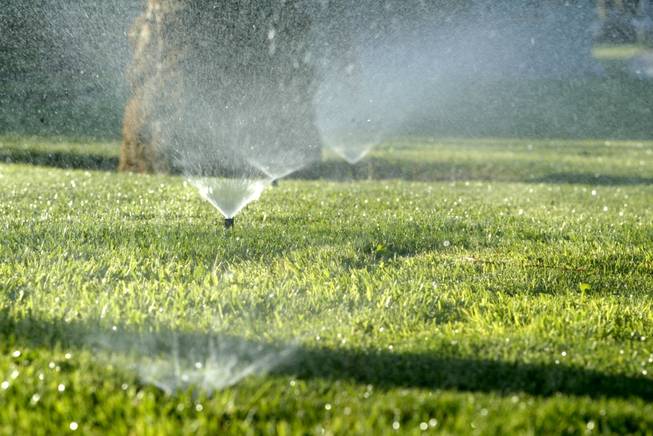
SUN FILE PHOTO
In this file photo, sprinklers irrigate a lawn in Henderson.
Friday, June 16, 2023 | 2 a.m.
Water in the Southwest
Nevada water officials came away from the 82nd state Legislature with some new regulatory powers, but legislation to address over-pumped water basins didn’t make it.
The passage of Assembly Bill 220 allows the Southern Nevada Water Authority to limit water use for residential homes in Clark County to about 163,000 gallons a year if Southern Nevada faces more restrictions on Colorado River water, agency spokesman Bronson Mack said.
“That’s a good stopgap to have for the Water Authority,” he said.
The average single-family home uses about 125,000 gallons a year, and only the top 20% of water users in Southern Nevada exceed that number, Mack said.
That top 20%, however, uses about 45% of all water provided to residences, he said.
Homes in general use about 60% of the water supplied each year. Last year, Southern Nevada consumed about 224,000 acre-feet of water, over 72.9 billion gallons.
“This legislation builds on our efforts to protect sustainable growth on the county and state levels,” Gov. Joe Lombardo said in statement, citing goals of balancing economic expansion with ensuring “clean and stable water into the future.”
Kyle Roerink, executive director of the Great Basin Water Network, said AB 220 is a positive development, but other important water-related bills fell to the wayside.
“Aside from 220, we had a lot of missed opportunities,” Roerink said. “We’re lucky we got what we got, but by comparison, Utah appropriated half a billion dollars for water-related issues.”
Roerink cited the failure of AB 387, which would have required the state engineer to “consider the best available science” when making decisions about groundwater use.
He also pointed to Senate Bill 176, which would have created a groundwater rights retirement and buyback program but got bogged down in the Senate Finance Committee.
“I think the big picture, at least on water this session, is that the end result is disappointing,” he said.
State Sen. Pete Goicoechea, R-Eureka, who sponsored SB 176, said he was “at a loss” as to why the bill failed to move forward. The bill requested $5 million to start the program.
The bill had support from the Nature Conservancy, the Sierra Club, the Southern Nevada Water Authority and the Nevada Farm Bureau, he said.
“It went to Senate Natural Resources unanimously, and then went to Finance and just never moved,” he said, speaking of the committees involved.
The buyback program would have compensated irrigators for retiring water rights they are no longer using.
Goicoechea called it “low-hanging fruit” to reducing demand on the aquifers.
Irrigation accounts for about 70% of the groundwater pumped annually in Nevada. With about half of some 256 groundwater basins being overpumped, it’s inevitable the state engineer will eventually have to curtail some water rights.
Goicoechea cited Senate Bill 113, which did pass, as an example of more stringent curtailment measures to come.
Roerink said the bill gives the State Engineer’s Office more power to curtail use in basins it designates as “critical management areas” that have been overpumped and overallocated.
Diamond Valley is now the only critical management area in the state.
The Nevada Supreme Court ruled in favor of a groundwater plan for Diamond Valley that calls for all irrigators to use less groundwater. The new bill changes the process for any future critical management areas, Roerink said.
“It does give us what I would call a pretty big hammer in critical management areas,” Roerink said. “The real question there is whether or not critical management areas are going to be designated.”
Goicoechea called Diamond Valley a “poster child” for overappropriated water basins, but he said it’s far from the only critical case in Nevada.
“We’re trying to head that off in other basins, and there are a number of them out there,” he said. “If they really get the data put together, they would find that they need to be designated a critical management area.”
Christi Cabrera-Georgeson, deputy director of the Nevada Conservation League, said the group was “a little disappointed to see” the deaths of AB 387 and SB 176, but there is still cause for celebration.
“I think we were still able to accomplish quite a bit this session,” she said.
Other water measures passed during the session include a provision in AB 220 establishing a program to help convert septic tank users to municipal sewer systems.
The bill also includes new regulations requiring parks, schools and cemeteries to install more water efficient grass and calls for those areas to be irrigated with water-efficient equipment.
The new state budget includes funding for 13 additional positions in the State Engineer’s Office, as well as funding for up-to-date crop inventories so the office can better track which water rights holders have forfeited their claims by not pumping within the last five years.
“We’ve got people ... it’s been 20 years since they’ve used their water, but the state engineer doesn’t have that data,” Goicoechea said.
[email protected] / 702-948-7836 / @Missmusetta
